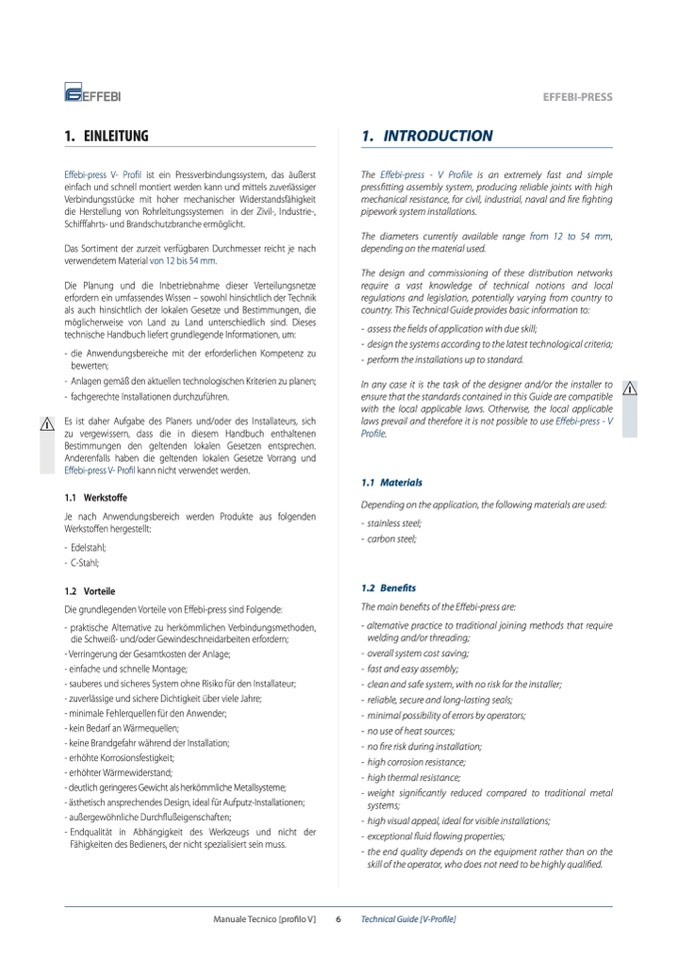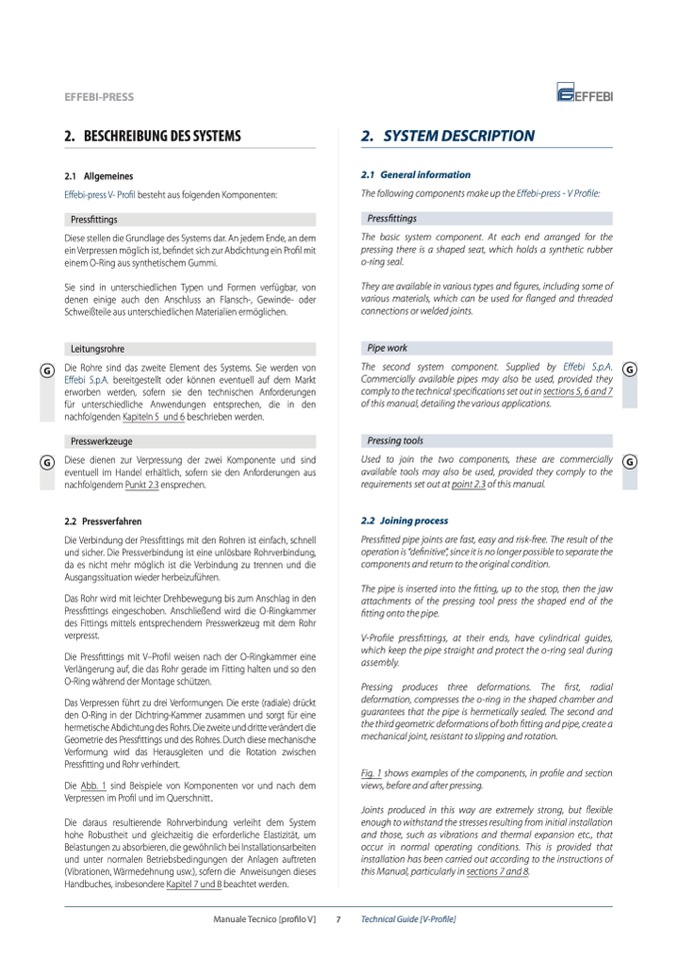


2.1 Allgemeines
Effebi-press V- Profil besteht aus folgenden Komponenten:
Pressfittings
Diese stellen die Grundlage des Systems dar. An jedem Ende, an dem
ein Verpressen möglich ist, befindet sich zur Abdichtung ein Profil mit
einem O-Ring aus synthetischem Gummi.
Sie sind in unterschiedlichen Typen und Formen verfügbar, von
denen einige auch den Anschluss an Flansch-, Gewinde- oder
Schweißteile aus unterschiedlichen Materialien ermöglichen.
Leitungsrohre
Die Rohre sind das zweite Element des Systems. Sie werden von
Effebi S.p.A. bereitgestellt oder können eventuell auf dem Markt
erworben werden, sofern sie den technischen Anforderungen
für unterschiedliche Anwendungen entsprechen, die in den
nachfolgenden Kapiteln 5 und 6 beschrieben werden.
Presswerkzeuge
G Diese dienen zur Verpressung der zwei Komponente und sind
eventuell im Handel erhältlich, sofern sie den Anforderungen aus
nachfolgendem Punkt 2.3 ensprechen.
2.2 Pressverfahren
Die Verbindung der Pressfittings mit den Rohren ist einfach, schnell
und sicher. Die Pressverbindung ist eine unlösbare Rohrverbindung,
da es nicht mehr möglich ist die Verbindung zu trennen und die
Ausgangssituation wieder herbeizuführen.
Das Rohr wird mit leichter Drehbewegung bis zum Anschlag in den
Pressfittings eingeschoben. Anschließend wird die O-Ringkammer
des Fittings mittels entsprechendem Presswerkzeug mit dem Rohr
verpresst.
Die Pressfittings mit V–Profil weisen nach der O-Ringkammer eine
Verlängerung auf, die das Rohr gerade im Fitting halten und so den
O-Ring während der Montage schützen.
Das Verpressen führt zu drei Verformungen. Die erste (radiale) drückt
den O-Ring in der Dichtring-Kammer zusammen und sorgt für eine
hermetische Abdichtung des Rohrs. Die zweite und dritte verändert die
Geometrie des Pressfittings und des Rohres. Durch diese mechanische
Verformung wird das Herausgleiten und die Rotation zwischen
Pressfitting und Rohr verhindert.
Die Abb. 1 sind Beispiele von Komponenten vor und nach dem
Verpressen im Profil und im Querschnitt..
Die daraus resultierende Rohrverbindung verleiht dem System
hohe Robustheit und gleichzeitig die erforderliche Elastizit
ät, um
Belastungen zu absorbieren, die gewöhnlich bei Installationsarbeiten
und unter normalen Betriebsbedingungen der Anlagen auftreten
(Vibrationen, Wärmedehnung usw.), sofern die Anweisungen dieses
Handbuches, insbesondere Kapitel 7 und 8 beachtet werden.
2.1 General information
The following components make up the Effebi-press - V Profile:
Pressfittings
The basic system component. At each end arranged for the
pressing there is a shaped seat, which holds a synthetic rubber
o-ring seal.
They are available in various types and figures, including some of
various materials, which can be used for flanged and threaded
connections or welded joints.
Pipe work
The second system component. Supplied by Effebi S.p.A.
Commercially available pipes may also be used, provided they
comply to the technical specifications set out in sections 5, 6 and 7
of this manual, detailing the various applications.
Pressing tools
Used to join the two components, these are commercially G
available tools may also be used, provided they comply to the
requirements set out at point 2.3 of this manual.
2.2 Joining process
Pressfitted pipe joints are fast, easy and risk-free. The result of the
operation is “definitive”, since it is no longer possible to separate the
components and return to the original condition.
The pipe is inserted into the fitting, up to the stop, then the jaw
attachments of the pressing tool press the shaped end of the
fitting onto the pipe.
V-Profile pressfittings, at their ends, have cylindrical guides,
which keep the pipe straight and protect the o-ring seal during
assembly.
Pressing produces three deformations. The first, radial
deformation, compresses the o-ring in the shaped chamber and
guarantees that the pipe is hermetically sealed. The second and
the third geometric deformations of both fitting and pipe, create a
mechanical joint, resistant to slipping and rotation.
Fig. 1 shows examples of the components, in profile and section
views, before and after pressing.
Joints produced in this way are extremely strong, but flexible
enough to withstand the stresses resulting from initial installation
and those, such as vibrations and thermal expansion etc., that
occur in normal operating conditions. This is provided that
installation has been carried out according to the instructions of
this Manual, particularly in sections 7 and 8.
G
G
Manuale Tecnico [profilo V]
7
Technical Guide [V-Profile]



